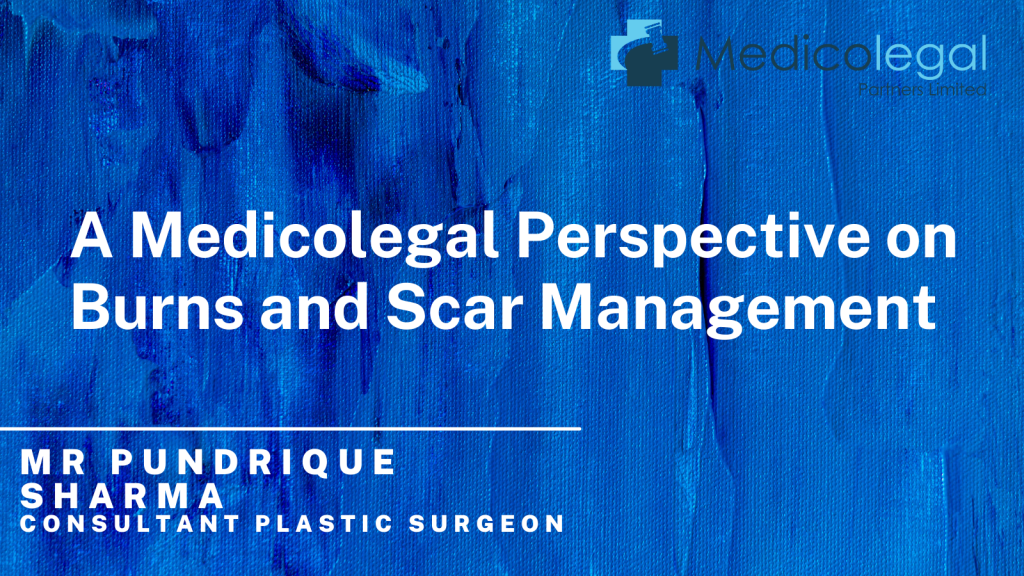A Medicolegal Perspective on Burns and Scar Management

Burns occur when the body is injured by contact with a number of different agents, including heat, chemicals, electricity or radiation. A scald is also essentially a burn, but specifically one caused by hot liquids or steam (1). Although burn injuries are fairly common (2–4), most are not serious and can be treated in a primary care situation (1,3). However, morbidity and mortality increase in line with the size and seriousness of the burn, and with the age of the patient (1). Even relatively small burns can be potentially life threatening in very young or elderly patients. Furthermore, beyond the risk to life, the complications of burns can have serious, and potentially life-changing, consequences in all patients.
The initial management of a patient with burns is no different from that of any other trauma patient. It is vital that a rapid and detailed assessment is made, so that important information is not missed (5), concurrent with urgent resuscitative management where appropriate . Examination should seek to establish the nature and extent of the burn, the exact mechanism of injury, the likelihood of inhalational injury and the presence of other injuries (1–3,5). A brief medical history is also essential, as some comorbidities, such as diabetes or smoking, can affect healing and increase the risk of complications (1,5).
Burns are categorised according to their severity, which is determined by the surface area affected, the depth of the burn and its location and extent. In adults, the percentage area of the burn is assessed by the Rule of 9s (3,6), in which the body is divided into anatomical regions that represent 9% (or multiples thereof) of the total body surface, with the palm and fingers making up the remaining 1% (6). However, in children, the head and legs represent different proportions of surface area than in adults, so this method is not precise enough (3,6), so frequently burns charts are used. Burns covering 15% or more of the body surface in an adult, or at least 10% in a child, are considered serious (6) and should be referred to Burns Centres.
Severity is also influenced by the depth of the burn. There may be more than one type within the same wound, which are referred to as mixed depth burns (6). Superficial thickness burns only affect the outer layer of the skin (the epidermis) and are considered minor in severity. Partial thickness burns penetrate the outer and underlying skin layer (the dermis), while full thickness, burns involve the entire thickness of the skin and beyond. All full thickness burns are considered to be serious, while superficial burns are only classified as such if they are large or occur on “special” areas such as the hands, face, feet or groin area, or over a major joint (6).
When treating a burn injury, the main aims are the resuscitation of the patient, limitation of tissue damage, promotion of rapid healing and prevention of infection (3,6). Initially, further burn damage can be mitigated by cooling the wound with water for around 30 minutes. Small wounds can be completely immersed (3,6,7). This procedure can be beneficial up to 3 hours after the occurrence of the injury. Although the optimal temperature of the water is still under debate, it is known that the use of ice can be detrimental as it can lead to prolonged vasoconstriction at the wound site (7). Large wounds should then be covered to prevent systemic heat loss and hypothermia, which is a particular danger in young children (5,6).
Patients with serious burns, as defined above, should be transferred to hospital as soon as possible (1,3,6), as the first six hours following injury are critical in reducing the risk of potentially life-threatening complications (6). Often the wounds should be debrided, so that all necrotic (dead) tissue is removed (3,6). This process will often need to be repeated over the first few days after the injury (6). Although the removal of blisters has been somewhat controversial, often a wound cannot be adequately assessed until all damaged tissue has been removed (7) and it is common practice to remove them.
Burn injuries activate an inflammatory response, which results in serious pathophysiological changes in the body, both at the burn site and in other areas of the body (2–4,7). Loss of intravascular fluid into the burn site and the formation of oedema in non-burned areas can rapidly lead to shock (2), and there is an increased risk of mortality if fluid resuscitation is delayed for more than 2 hours after the occurrence of the injury (4). It is therefore vital that initial management of a patient with burns includes restoration of the intravascular volume with fluids. This will preserve tissue perfusion and minimise inflammatory responses and tissue damage (2). As the fluid losses are likely to be ongoing until healing is established, fluid resuscitation may be needed for some time (7). Various formulae have been developed to guide the amount of fluid resuscitation required, of which the most widely used is the Parkland formula. However, some groups may require additional fluids, including patients with inhalation injuries or electrical burns, or those in whom resuscitation has been delayed (4). On the other hand over-filling with fluid can be equally dangerous, as lung tissue can become porous in burns, and so the lungs can fill with fluid (pulmonary oedma).
Beyond the initial life threatening risk of some major burns, there are many potential complications following a burn injury, and two with the most potential impact are infection and scarring. Infection can delay or prevent healing and some infections may even be fatal. Therefore, burn injuries should be regularly inspected for signs of infection.. If infection does occur, antibiotics should be administered promptly. However, the prophylactic use of antibiotics is not recommended, due to the risk of adverse reactions and microbial resistance (4). Topical antibiotics can be useful (3,4,6) but often cause side effects, so an alternating regimen of agents should be considered (6). The prevention of sepsis is absolutely critical in the management of patients with burns, and it is vital that if this condition does develop, it is recognised quickly and appropriate antibiotic therapy is given (4).
Scarring can be a major issue following a burn injury. As well as changes in appearance and function, scarring can lead to an alteration in body image, stigmatisation and social isolation. Psychiatric symptoms, such as depression and anxiety, may also occur (1,3). Burns that take more than 2-3 weeks to heal are much more likely to result in hypertrophic scarring, which is highly visible and may be uncomfortable for the patient (1,3,6). Over time, most scars flatten and fade, but this process can take several years, and it is difficult to predict the final outcome (6). Scarring can cause particular problems in children. When the rest of the body grows, the scar does not and this can lead to contractures. If these are situated on or near a joint, they can affect its growth and function. Facial contractures may lead to deformities of the mouth, which interfere with eating and speech, while those near the eye may result in ectropion, in which the eyelid is turned outwards. This can lead to irritation of the eye and ultimately blindness (6).
In cases where the patient’s hands are burned, the aim of treatment should be to preserve as much function as possible (6). The fingers should be dressed individually, in order to prevent the development of webbing during healing. This procedure also allows the hands to be used in daily activities and mobilisation exercises during recovery. Preservation of the first web space (the gap between the thumb and index finger) is also important, as it helps to maintain the grasp function of the hand (7). For the first 48 hours, the hands should be kept in an elevated position, but after this, gentle hand exercises can begin. Where skin grafting is deemed necessary, referral to a specialist should be done (6).
While many superficial burns heal quickly, serious burns can take much longer and complications are common. As these can be life-changing, the severity of the wound needs to be assessed as soon as possible, so that the patient can be transferred to a specialist burns unit if necessary (5). It is likely that a long-term care programme will be needed for the most seriously affected patients (6), which should include frequent re-assessment of the wound throughout the healing process. As well as infection and scarring, many patients face complications caused by chronic pain and psychiatric symptoms such as anxiety, depression and post-traumatic stress disorder (3,7). It is important that all of these are identified quickly, and appropriate treatment given so that their impact is minimised. Despite all these factors, outcomes after burn injuries have improved significantly in recent years, with reductions in both mortality and length of hospital stay, reflecting advances in critical care during this time period (4).
About our expert
Mr Pundrique Sharma is a Consultant Plastic Surgeon at the Alder Hey Children’s Hospital. He accepts instructions as an expert witness in adult and paediatric cases involving general plastic surgery, reconstruction and burns surgery. Mr Sharma has a special interest in limb reconstruction and nerve injuries, including obstetrical brachial plexus injury. He has also set up a hand fracture clinic, particularly dealing with finger and thumb fractures, as well as metacarpals.
Mr Sharma can also act as an expert in cases involving cosmetic surgery across a variety of surgical aesthetic procedures, including breast surgery, abdominoplasty and liposuction.
References
1. Burns and scalds | Health topics A to Z | CKS | NICE [Internet]. [cited 2022 Jan 25]. Available from: https://cks.nice.org.uk/topics/burns-scalds/
2. Bittner EA, Shank E, Woodson L, Martyn JAJ. Acute and perioperative care of the burn-injured patient. Anesthesiology. 2015 Feb;122(2):448–64.
3. Morgan ED, Bledsoe SC, Barker J. Ambulatory management of burns. Am Fam Physician. 2000 Nov;62(9):2015-2026,2029-2030,2032.
4. Snell JA, Loh N-HW, Mahambrey T, Shokrollahi K. Clinical review: the critical care management of the burn patient. Crit Care. 2013 Oct;17(5):241.
5. Hettiaratchy S, Papini R. Initial management of a major burn: I–overview. BMJ. 2004 Jun;328(7455):1555–7.
6. WHO. Management of Burns [Internet]. 2003 [cited 2022 Jan 25]. Available from: https://www.who.int/surgery/publications/Burns_management.pdf
7. Allorto NL. Primary management of burn injuries: Balancing best practice with pragmatism. South African Fam Pract Off J South African Acad Fam Pract Care. 2020 Sep;62(1):e1–4.




